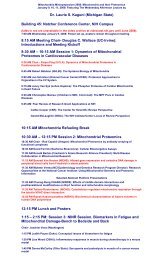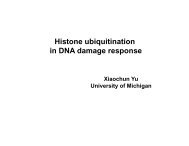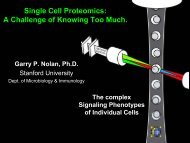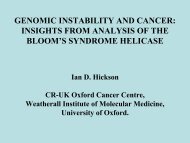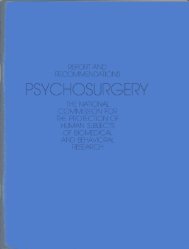RESEARCH ON THE FETUS - National Institutes of Health
RESEARCH ON THE FETUS - National Institutes of Health
RESEARCH ON THE FETUS - National Institutes of Health
Create successful ePaper yourself
Turn your PDF publications into a flip-book with our unique Google optimized e-Paper software.
STATEMENT OF COMMISSI<strong>ON</strong>ER KAREN LEBACQZ,<br />
WITH <strong>THE</strong> C<strong>ON</strong>CURRENCE OF COMMISSI<strong>ON</strong>ER ALBERT R. J<strong>ON</strong>SEN<br />
<strong>ON</strong> <strong>THE</strong> FIRST ITEM<br />
The following comments include some points <strong>of</strong> dissent from the Recommen-<br />
dations <strong>of</strong> the Commission. For the most part, however, these comments are<br />
intended as elaborations on the Report rather than dissent from it.<br />
1. At several points, the Commission established as a criterion for<br />
permissible research an acceptable level <strong>of</strong> risk--e.g., "no risk" or "minimal<br />
risk." I support the Commission's Recommendations regarding such criteria, but<br />
I wish to make several interpretative comments.<br />
First, I think it should be stressed that in the first trials on human<br />
subjects or on a new class <strong>of</strong> human subjects, the risks are almost always<br />
unknown. The Commission heard compelling evidence that differences in physiology<br />
and pharmacology between human and other mammalian fetuses are such that even<br />
with substantial trials in animal models it is <strong>of</strong>ten not possible to assess the<br />
risks for the first trials with human fetuses. For example, evidence from animal<br />
trials in the testing <strong>of</strong> thalidomide provided grounds for an estimation <strong>of</strong><br />
low risk to human subjects; the initial trials in the human fetus resulted in<br />
massive teratogenic effects.<br />
I would therefore urge review boards to exercise caution in the interpretation<br />
<strong>of</strong> "risk" and to avoid the temptation to consider the risks "minimal"<br />
when in fact they cannot be fully assessed.<br />
Second, I think it important to emphasize the evaluative nature <strong>of</strong> judgments<br />
<strong>of</strong> risk. The term "risk" means chance <strong>of</strong> harm. Interpretation <strong>of</strong> risk<br />
involves both an assessment <strong>of</strong> statistical chance <strong>of</strong> injury and an assessment<br />
<strong>of</strong> the nature <strong>of</strong> the injury. Value judgments about what constitutes a "harm"<br />
and what percentage chance <strong>of</strong> harm is acceptable are both involved in the determination<br />
<strong>of</strong> acceptable risk. A small chance <strong>of</strong> great harm may be considered<br />
unacceptable where a greater chance <strong>of</strong> a smaller harm would be acceptable. For<br />
example, it is commonly accepted that a 1-2 percent chance <strong>of</strong> having a child with<br />
Down's syndrome is a "high" risk, where the same chance <strong>of</strong> minor infection from<br />
83



